Save time, reduce frustration, and have insurance claims paid faster!
UPDATED 3/31/2022
Insurance carriers are constantly updating their requirements for reimbursement. This means the rules of the game are changing regularly, and if you’re caught unawares, your claims will keep coming back denied. Let’s explore what insurances are looking for on a claim in order to timely process payment, what Dentrix tools you should be utilizing, and why you need to review each claim for accuracy prior to submitting.
The quality, or cleanliness, of each insurance claim directly impacts the likelihood of approval and the speed of payment and processing. Here are seven ways you can improve the quality of your insurance claims so they are squeaky clean and less likely to be rejected — saving you time and money on appeals, write-offs and suffering cash flow.
1 – Begin the credentialing process as soon as providers are ready to join the practice.
Best practice is to start the credentialing process for a new provider as early as possible. If you are unable to obtain the necessary information to start the process, have an internal protocol for scheduling patients with that provider. An important question to ask when credentialing a provider is if credentialing will be effective on the application date or approved date. This will help you with scheduling and claim submission.
2 – Submit in the most current ADA format.
If your claims are continually rejected by your clearinghouse or not on file with insurance companies, you may be using the incorrect ADA claim form. The current ADA format for claims is the 2019 form, which is available in Dentrix G7.3 and later. Once you have the correct claim format chosen, Dentrix generates all claims on that new claim form.
3 – Use the correct CDT codes for the procedures completed.
With coding changes and additions happening yearly, best practice is to match the CDT code with the nomenclature—or the code description. Submitting the correct CDT codes on the claim holds the door open for more successful appeals if the insurance carrier denies services. While several coding resources are available, I recommend the 2022 CDT Edition of Coding with Confidence.
4 – Maximize your claim refunds.
Does your practice charge out full office fees or PPO fees on the ledger? Whatever your practice preference, it is highly recommended to have the UCR costs on the outgoing claim form. The insurance EOB will state if a non-covered service can be billed to the patient with the full office fee. If there is no PPO discount on non-covered services, the patient is responsible for 100% of the office fee. Check here for your state allowances on billing full office fees to patients.
5 – Submit under the correct rending provider.
Check all claims for the correct credentialed rendering provider before sending them to the insurance carriers. If the rendering provider is an associate provider, confirm that the billing provider is correct on the claim also. Only the doctor who performs the exam is the rendering provider; hygienists do not need to be listed on the claim.
6 – Always have accurate patient insurance information.
Your insurance verification affects the quality of your claims. The number one reason why claims don’t get processed is incorrect patient and/or insurance information. With 65 percent of offices being insurance-driven, verifying and reviewing the insurance information is crucial to healthy revenue cycle management.
7 – Don’t forget to include documentation and attachments.
To send a squeaky-clean claim, you need SOAP, which is a format for clinical notes that stands for:
- Subjective – The patient’s chief complaint as communicated by the patient, history of present illness, location, and severity.
- Objective – Vital signs, examination findings, health history update.
- Assessment – Diagnosis, reasoning/evidence behind the diagnosis if applicable.
- Plan – How the provider will treat the patient’s concern.
It is important to have dated clinical notes that include all clinicians’ signatures. This means notes and signatures for the rendering provider (dentist) and then the hygienist or dental assistant that assisted with the visit.
The necessary attachments for services differ depending on the insurance carrier, but typically, critical supportive clinical documentation includes current periodontal charting, current pre-op X-rays, and pre-op and post-op intra-oral photos. Be sure to also include the date of prior placement of a crown, bridge, or denture if you are replacing an existing restoration.
Sending clean claims daily ensures timely reimbursement and steady cash flow for your practice. Don’t let your claims pile up. Outsourcing your dental billing processes to eAssist Dental Solutions unburdens the in-house team from the heavy workload that is outstanding insurance collectibles. Combined with the powerful, user-friendly Dentrix practice management software, you can drive the success of the practice, feel confident that you are using best insurance billing practices, and finally get that pot of gold as you start collecting everything that you are owed from insurance carriers.
Learn More
If you would like to learn more about adding a team of insurance claim and collections experts to your Dentrix solution, visit https://www.Dentrix.com/eAssist/GetYourGold.
For additional information, read Do You Avoid Patient Collectibles?
The product(s) and/or service(s) described herein are provided by a third party and the content and descriptions were created by such third party. Henry Schein, Inc. or its affiliates (“HSI”) make no independent assessment of the content and descriptions provided by such third party and this advertisement do not constitute an endorsement by HSI. HSI is not responsible for, and expressly disclaims, all liability for damages of any kind arising out of such third-party products or services. [HSI receives a marketing fee from the third-party provider for products/services purchased.]
By Lindsay Salazar, Dental biller and Dentrix user of 22 years, eAssist Dental Solutions





